
Sex is the trait that determines whether a sexually reproducing organism produces male or female gametes. During sexual reproduction, a male and a female gamete fuse to form a zygote, which develops into an offspring that inherits traits from each parent. By convention, organisms that produce smaller, more mobile gametes are called male, while organisms that produce produce larger, non-mobile gametes are called female. An organism, such as most flowering plants, that produces both types of gamete is a hermaphrodite.
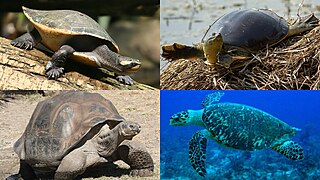
Turtles are reptiles of the order Testudines, characterized by a special shell developed mainly from their ribs. Modern turtles are divided into two major groups, the Pleurodira and Cryptodira, which differ in the way the head retracts. There are 360 living and recently extinct species of turtles, including land-dwelling tortoises and freshwater terrapins. They are found on most continents, some islands and, in the case of sea turtles, much of the ocean. Like other amniotes they breathe air and do not lay eggs underwater, although many species live in or around water.

Butterflies are winged insects from the lepidopteran suborder Rhopalocera, characterized by large, often brightly coloured wings that often fold together when at rest, and a conspicuous, fluttering flight. The group comprises the superfamilies Hedyloidea and Papilionoidea. The oldest butterfly fossils have been dated to the Paleocene, about 56 million years ago, though they may have originated earlier.

Extinction is the termination of a taxon by the death of its last member. A taxon may become functionally extinct before the death of its last member if it loses the capacity to reproduce and recover. Because a species' potential range may be very large, determining this moment is difficult, and is usually done retrospectively. This difficulty leads to phenomena such as Lazarus taxa, where a species presumed extinct abruptly "reappears" after a period of apparent absence.

Herring are forage fish, mostly belonging to the family of Clupeidae.

Endemism is the state of a species only being found in a single defined geographic location, such as an island, state, nation, country or other defined zone; organisms that are indigenous to a place are not endemic to it if they are also found elsewhere. For example, the Cape sugarbird is found exclusively in southwestern South Africa and is therefore said to be endemic to that particular part of the world. An endemic species can also be referred to as an endemism or, in scientific literature, as an endemite.

A flower, also known as a bloom or blossom, is the reproductive structure found in flowering plants. Flowers consist of a combination of vegetative organs – sepals that enclose and protect the developing flower, petals that attract pollinators, and reproductive organs that produce gametophytes, which in flowering plants produce gametes. The male gametophytes, which produce sperm, are enclosed within pollen grains produced in the anthers. The female gametophytes are contained within the ovules produced in the carpels.

Nysius is a genus of false chinch bugs in the family Lygaeidae. At least 100 described species are placed in Nysius.
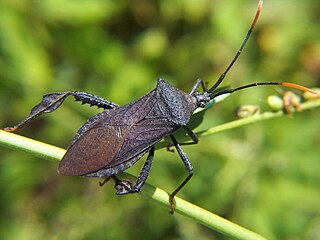
Acanthocephala, also known as spine-headed bugs, is a New World genus of true bugs in the family Coreidae. The scientific name is derived from the Greek ἄκανθα (akantha) meaning "thorn/spine" and κεφαλή (kephale) meaning "head". This name refers to the diagnostic spine on the front of the head.
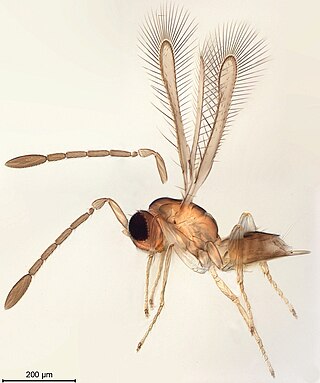
Arescon is a genus of fairyflies. It contains the following species:

Belostoma is a genus of insects in the hemipteran family Belostomatidae, known colloquially as giant water bugs. Members of this genus are native to freshwater habitats in the Americas, with the greatest species richness in tropical South America. Most species in the family Belostomatidae have historically been included in Belostoma, but several of these have been moved to other genera. 9 species are claimed to be found in Northern America, but the genus Belostoma is actually divided into 16 subgroups containing about 70 species.
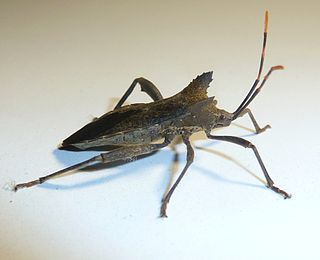
Elasmopoda is a genus in the "true bug" family Coreidae, order Hemiptera. The genus is native to parts of eastern and southern Africa. The species are large "twig wilter" bugs, generally brown or greyish. The femora of the hind legs are somewhat enlarged and bent, but less than those of some related genera, and either unarmed, or less armed with spikes.

Rhytiphora is a genus of flat-faced longhorn beetles in the Pteropliini tribe of the subfamily Lamiinae. The genus was first described in 1835 by Jean Guillaume Audinet-Serville.
Rhytiphora dallasi is a species of beetle in the family Cerambycidae. It was described by Francis Polkinghorne Pascoe in 1869. It is known from Australia.

Ochrimnus is a genus of seed bugs in the family Lygaeidae. There are more than 40 described species in Ochrimnus.
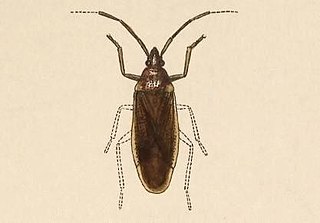
Lethaeini is a tribe of dirt-colored seed bugs in the family Rhyparochromidae. There are more than 40 genera and 180 described species in Lethaeini.
Amnestus is a genus of burrowing bugs in the family Cydnidae. There are more than 40 described species in Amnestus.
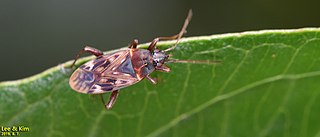
Neolethaeus is a genus of dirt-colored seed bugs in the family Rhyparochromidae. There are more than 20 described species in Neolethaeus, found mainly in Asia, Australia, and Africa.

Neolethaeus assamensis is a species of dirt-colored seed bug in the family Rhyparochromidae, found in south and eastern Asia.

















